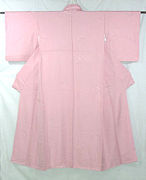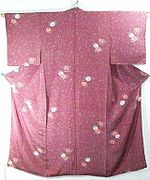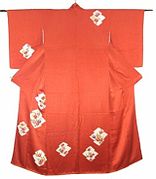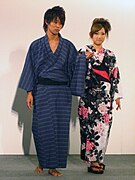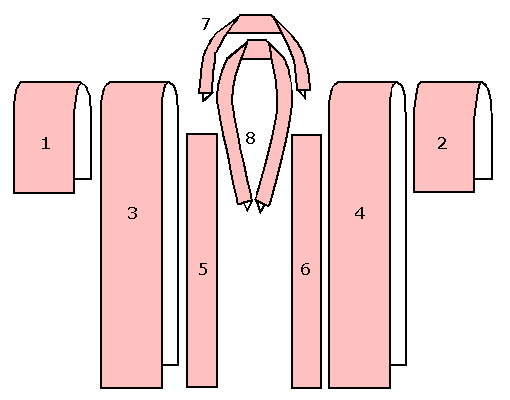kimono
Kimono ( jap. 着 d, dt. "Anziehsache" from kiru = to wear and mono = thing) is a traditional Japanese caftan-like piece of clothing that is held together by a wide belt ( obi ).
history
Originally, the word kimono applied to all types of clothing.
Today's kimono took shape in the Heian period (794–1192). Since then, the basic shape of the kimono has remained largely unchanged for both men and women: a T-shaped, straight robe that reaches to the ankles, a collar and wide sleeves. If you stretch your arms out horizontally, the sleeves will fall from your wrist to about your hips (in some styles, the sleeves can even almost touch the floor). The robe is wrapped around the body, always with the left side over the right. The kimono is held together by a sash-like belt, the obi . It is tied at the back.
Over time there have been many variations in color, fabric and style, also in accessories such as the obi .
Today kimonos are preferred to be worn on special occasions, mostly by women. Men often wear kimonos at weddings and tea ceremonies . Kimonos are also worn for certain sports, such as kendo . There are a large number of kimono hobbyists in Japan who can take kimono- wearing lessons. Such lessons cover various topics: choosing fabrics and patterns that are appropriate for the season and the event, suitable underwear and accessories for the kimono, choosing and tying an obi , etc.
Most Japanese women would not be able to put on a kimono correctly without further help. The typical outfit for women usually includes twelve or more individual pieces, each of which must be put on in a specific way. (Men's kimonos are much simpler, usually there are no more than five pieces, as well as socks and sandals.) There are still professional kimono donners who can be hired to provide support, especially for special occasions. Members of this profession must acquire a license. They often work in hairdressing salons, but usually come to the customers' homes if requested.
There are still older women and, to a lesser extent, men who wear kimono every day. Professional sumo wrestlers must wear a kimono when performing in public outside the ring.
Nowadays the kimono is rarely worn in public, mainly by geishas . The kimono also includes getas (wooden sandals), jewelry and, in the case of short, d. H. waist-length, kimonos a hakama . Men may still find netsuke (wooden figurines), which served as a counterweight to the Inrō pocket substitute .
Handling and use
The kimonos for women are essentially one size. They are clamped and folded to suit the individual physique. Nowadays, however, both kimonos for men and women are increasingly available in different sizes. Very tall or heavily built people (such as sumo wrestlers ) need a specially tailored kimono.
In the past, kimonos were often completely taken apart so that they could be washed in pieces. Then the parts were sewn back together. Modern washing methods and fabrics have made this procedure largely superfluous. Sometimes a folded kimono is basted with wide, loose stitches for storage. This prevents wrinkles or wrinkles from appearing while holding the different layers of the kimono together.
There are styles of kimono for different occasions, from the very formal to the very casual. The degree of formality of a woman's kimono is determined by the pattern, fabric and color. Men's kimonos are generally cut in the same way and are usually worn in darker colors. The formality is mainly determined by the fabric and color, as well as by the number or lack of mon , family crests. Silk is the most desirable and formal fabric, while wool , linen, and cotton are more casual. Nowadays there are also kimonos made of polyester ; these are usually rather casual.
Kimonos are made from a single bale of fabric. These bales have fixed dimensions and all of the fabric is used to make the kimono. This is why larger cut kimonos are hard to find and very expensive to make.
Usually kimonos are expensive. High-quality kimonos are hand-sewn, and the fabrics used are also often handmade and lavishly decorated. A single women's kimono can easily cost more than € 10,000; Complete equipment - kimono, undergarments, obi , ribbons, socks, sandals and accessories - can cost over € 20,000. A single obi can be worth thousands of euros. In fact, most of the kimonos used by hobbyists or representatives of traditional art are far less expensive. Enterprise-minded people can easily tailor their kimono or undergarments themselves, as they follow a standard shape. Old kimonos can also be remodeled. Cheaper and machine-woven fabrics can be used instead of the hand-worked silk. Finally, there is also a flourishing trade in used kimonos in Japan . However, obi for women remain expensive. Even secondhand, they can cost hundreds of dollars and are difficult for the inexperienced to make. Men's obi are a lot cheaper, even those made of silk. This is primarily due to the fact that these obi are significantly narrower, shorter and significantly simpler than women's obi .
Kimonos are never wasted. Old kimonos are recycled in various ways: they are made into haoris or children's kimonos ; their fabric is used to mend similar kimonos; they are used to make kimono accessories such as handbags or covers, bags and housings for various utensils, e.g. B. Candy tongs (used in tea ceremonies ) or unique ceramic items. Men's kimonos that are damaged in the lower area can still be worn under the hakama so that the blemish is not visible.
Women's kimono
There are several types of kimonos worn by women these days. They are selected according to age and occasion. In the following the different types of kimonos are listed in descending order of formality.
Note: Pattern is used here to mean ornamentation, motif (generally not regular / repeated ). Is only meant as a regular pattern if specified separately.
- Kurotomesode ( 黒 留 袖 , literally: black attached sleeves ): black kimono that is only patterned below the waist. Kurotomesode is the most formal of the kimonos for married women. Often worn by the mothers of the newlyweds at the wedding. Usually on Kurotomesode five Kamon (family seal) on the sleeves, chest and back of the kimono.
- Furisode ( 振 袖 , literally: shaking sleeves): The sleeves are usually 100–110 cm long. The furisode is the most formal kimono for unmarried women. It is patterned over a large area. It is usually worn by unmarried relatives at "legal age ceremonies " (e.g. the Seijin no hi ) or at weddings and wedding receptions .
- Irotomesode ( 色 留 袖 , literally: colored attached sleeve ): Irotomesode is a monochrome kimono that is only patterned below the waist. It's a little less formal than the Kurotomesode. The irotomesode can show three or five kamons. It is only worn by married women. Usually close relatives of the bride and groom wear the Irotomesode at the wedding.
- Hōmongi ( 訪問 着 , literally: visiting clothes ): Patterns that flow over shoulders, sleeves and seams are typical. Hōmongi are slightly more formal than the similar tsukesage. Hōmongi are worn by both married and single women. Usually friends of the bride and groom wear Hōmongi at the wedding. They are also worn on formal occasions such as receptions or galas.
- Tsukesage ( 付 け 下 げ ): The tsukesage has simpler patterns that take up less space than the Hōmongi, mainly below the waist. It is worn by both married and single women.
- Iromuji ( 色 無 地 , literally: colored, unpatterned ): Monochrome kimono, which is also worn by married and single women. The dyed silk can be structured ( rinzu ), but has no different colored patterns. The Iromuji is mainly worn for tea ceremonies .
- Komon ( 小 紋 , literally: fine pattern ): Is a kimono with a small repeating pattern all over the fabric. Is worn in everyday life. Supplemented by an obi as evening wear. Again for married and single women.
- Edo Komon ( 江 戸 小 紋 ): Is a variety of Komon . It is characterized by small dot-like patterns that result in larger images. The Edo Komon -Färbetechnik originated with the samurai caste in the Edo period . It is just as formal as the Iromuji and, if it shows a kamon , also suitable as "visiting clothes " (equivalent to Tsukesage or Hōmongi ).
- Shiromuku , (literally: Shiro = white and muku = pure ): traditional wedding kimono which is usually made of white silk brocade with woven, auspicious motifs (crane, pine, etc.). Like the uchikake, it is significantly longer than other kimonos and has a padded train hem. Since it is very expensive, it is very often rented nowadays for "only" a few thousand euros or is simply inherited. For a Shiromuku, the bride wears a white bridal cap ( Watabōshi or Tsunokakushi ).
- Mofuku ( 喪服 , "mourning clothes"): A general term for mourning clothes including western ones ; however, when referring to Japanese clothing, mofuku refers to a mourning kimono for men and women that is worn by close relatives at funerals. The basic color is black without a pattern and possibly with kamon. A black obi and mostly white tabi are worn with the mofuku.
- Uchikake : Colored wedding kimono of the bride made of heavy silk brocade interwoven and embroidered with lucky symbols. The most popular base color of the Uchikake is red; but there are also black or other colors. Most of the decorations are gold and silver in color. The sleeve tails hang down to the ankles. The uchikake is approx. 30–40 cm longer than the other kimonos, so that the lower hem drags across the floor. For the uchikake, the bride does not wear a headgear, but only a magnificent headdress. Without help, the bride cannot properly dress the uchikake or move around properly with it. Until the Edo period (1603–1867), the uchikake was the formal kimono used by samurai women and aristocrats.
Geisha kimonos
Since geisha are not ordinary Japanese housewives, they differ not only in their appearance on the face, but also, for example, in the wardrobe.
- The suzohiki is the traditional kimono for the geishas. The sleeve length is reminiscent of a tomesode. The colors are different, depending on the season or the occasion, from black to purple. Mostly it is muted colors that are not conspicuous, because the geisha wants to attract attention with her art and less with her appearance. In addition, the suzohiki kimonos are very long in length when worn, it would drag across the floor when walking normally. A geisha would never do that. Geisha always carry their kimono with a refined, very elegant handle in front of the upper stomach, so that it never touches the floor unnecessarily. Like the wedding kimono Uchikake and Shiromuku, a suzohiki is only placed on the floor at photo appointments, but is picked up again at the first step. To the Susohiki carries either silk Zori or if it rains, the wooden Geta .
- The hikizuri is the traditional kimono for the maikos (geisha trainees). The maikos also differ in appearance from the geishas. While the geishas, who are older, their faces painted less conspicuous and behavioral wearing maiko bright colors, lush Kanzashi -Haarschmuck and high platform shoes, which also act very childish, because the Maiko to act young, the traditional education about six and a half years, but is now possible from the age of 16. Therefore, the Hikizuri is often provided with lush, colorful patterns and the basic colors are mostly bright green, or blue, since the Maiko should look childlike to show the lack of maturity in contrast to the trained geisha. Furthermore, the Hikizuri has long sleeves, but they are shorter than the Furisode, as long sleeves would interfere with dancing. In addition, as with the suzohiki, the height is very long. Unlike the geisha, the maiko does not wear simple hair accessories with her hikizuri, but brightly colored, striking and lush kanzashi hair accessories. She also wears the typical platform shoes , the Okobo .
The hikizuri kimono is also often used in Kabuki to play the role of a young girl (e.g. Bandō Tamasaburō in Sagi Musume ).
Men's kimono
Modern men's kimonos mainly differ in fabric and design. Most are muted, dark in color. Black and dark blue and green tones, sometimes brown, are common. Fabrics are usually matte. Some have a fine pattern; textured fabrics can be found on rather loose kimonos. Less formal kimonos can be a slightly lighter color, such as more delicate shades of purple, green, and blue. Some sumo wrestlers occasionally wear fairly light colors like magenta .
The most formal style of kimono for men is plain black with five kamons on the chest, shoulders and back. The kimono with three kamons is a little less formal . This is usually combined with white underwear and accessories.
Almost any kimono outfit can be made more formal by wearing hakama and haori .
historical: Kamishimo (here with Ichimonjigasa headgear)
historical: Hitatare
construction
|
Women's kimonos have an opening ( 身 八 つ 口 , miyatsukuchi / miyatsuguchi ) under the left and right armholes in the armpits , as well as a further opening ( 振 八 つ 口 , furiyatsuguchi or 振 り 口 , furikuchi ) below the sleeves . The name yatsuguchi ( 八 つ 口 ) comes from the fact that with these four additional openings, together with those for the arms, neck and lower body, a woman's kimono has "eight openings".
Kimono can be cut from a piece of fabric as follows (there are several cut variants, depending on the kimono):
|
This results in the following pieces:
Accessories and related clothing
- Yukata
- Informal summer kimono, usually made from cotton, linen, or hemp. Yukata are mainly worn at outdoor festivals by women and men of all ages.
- Dancing / Dotera
- Informal winter kimono that is padded with cotton.
- Geta
- Geta are wooden thong sandals that are worn with yukata by both men and women. A variant of the Geta is worn by the maiko ( geisha trainees) ( okobo ).
- Hakama
- A skirt or trouser skirt, more like a very loose pair of pants. Traditionally only worn by men, but now also by women. A hakama usually has folds and a koshiita - a stiff or padded area on the lower back. Hakama are also worn in various Budō arts , for example in Aikidō , Kendō , Kyūdō , Iaidō and Naginatadō . Again, the degree of formality is determined by the pattern. While very formal women's outfits do not include hakama , they are common for men.
- Haori
- Kimono covering in the manner of a jacket that goes up to hip or thigh height. It creates more formality. Haori were originally reserved for men only, but fashion changed at the end of the Meiji period . Today, haori are worn by both men and women, with women's jackets tending to be longer.
- Haori-himo
- A fringed, woven fastening cord for the Haori . The most formal color is white.
- Obi
- The Japanese equivalent of a sash or belt. Can be worn with a kimono or yukata . Obi are worn differently depending on the occasion. The versions for outfitting the female kimono wearer are the most complicated.
- Tabi
- Ankle-high socks with a separate toe area. Usually worn with sandals. Also available for boots.
- Waraji
- Straw sandals, which are preferred by monks .
- Zori
- Thong sandals traditionally made of leather, fabric or rice straw. Zori can be richly decorated with delicate embroidery - or not at all. They are worn by both men and women. The most formal men's zōri have an insole made of rice straw and toe straps made of white leather. In terms of design, they are similar to sandals . Women's zōri have a narrower and more oval shape than men's zōri .






